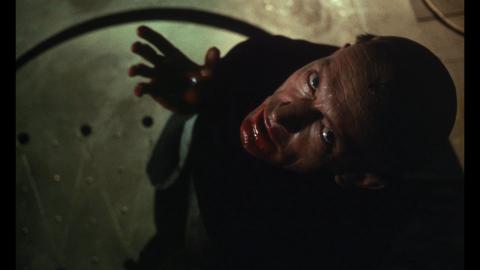Stuart Gordon's THE PIT AND THE PENDULUM - Action, Absurdity, and Gross-out Horror

Lance Henriksen in Stuart Gordon's THE PIT AND THE PENDULUM (1991).
These notes on Stuart Gordon's The Pit and the Pendulum were written by Faye Mitchell, who received her MA in Film from the Department of Communication Arts at UW-Madison. A 35mm print of The Pit and the Pendulum will screen as part of the Cinematheque's ongoing series honoring the late, great filmmaker Gordon at the Chazen Museum of Art on Sunday, October 16 at 2 p.m. The print comes from the Gordon collection at the Wisconsin Center for Film & Theater Research. Admission is Free.
By Faye Mitchell
Deep in a crypt, a coffin’s lid is removed for a gaggle of spectators. Agents of the Spanish Inquisition quibble and joke about carefully raising its decomposed inhabitant out of his tomb. Out comes a grotesque skeleton, made to face judgment for sins long and forgotten by the Grand Inquisitor Torquemada (Lance Henriksen), who declares the dead man to be a heretic. His descendants’ wealth is seized by the church and the skeleton receives exactly 20 lashes and not a single lash more. The camera cuts between the corpse, strung up on chains to receive his punishment, his distraught family that is made to watch, and the pale, ghoulish faces of the Inquisition, delighting in the barbaric act.
These opening moments of Stuart Gordon’s fifth feature, The Pit and the Pendulum, establish the tone that will predominate much of the film: gross and campy, but also comically absurd. In 1991, Gordon was best known for his low-budget horror films, adapting two of H.P. Lovecraft’s stories, chosen partly because they were in the public domain and free to use, into Re-Animator (1985) and From Beyond (1986). Two years prior, he had co-written Disney’s Honey, I Shrunk the Kids, a wildly successful family film starring Rick Moranis, but he returned to the realm of public domain for The Pit. Gordon and screenwriter Dennis Paoli – a frequent collaborator in the director’s early career – pick up the proto-Kafka narrative of the eponymous Edgar Allan Poe short story that the film is loosely adapting and run with it. The Inquisition is plain in its mission but arbitrary in its execution. It seeks confession through torture and rejects any confession offered without it. Once you are deemed guilty, there isn’t enough of either to prove your innocence or earn your freedom. The system is maddening but Paoli imbues the script with enough moments of levity to prevent it from suffocating Gordon’s characteristically goofy filmmaking.
At the center of it all is Torquemada. Henriksen, best known for his role as the android Bishop in Aliens (1986), delivers a powerhouse performance pitched perfectly to the film’s grand campiness. Caught between his devout belief in the religious righteousness of the Inquisition and his sudden lust for a newly accused heretic, Henriksen plays Torquemada’s growing madness as pathetic and frightening. Gordon makes excellent use of close-ups and hard lighting to let Henriksen’s wide-eyed menace control the scene.
For most of its run time, The Pit and the Pendulum does not read like a conventional horror film of the era. There are no jump scares, and the special effects and gore are relatively tame compared to Gordon’s earlier Lovecraft adaptations. Instead, it can be seen as a precursor to the torture porn subgenre of horror, reflected through the prism of its early 90s, low-budget sensibilities. Popularized in the 2000s by films like Hostel (2005) and the Saw franchise, films of this ilk derive their terror from the spectacle of prolonged, often extremely gory, torture sequences. Much has been written on the echoes of 9/11 and its consequences in these films, filmmakers and audiences alike trying to make sense of the United States’ use of torture at Abu Ghraib. The Pit and the Pendulum similarly uses torture as a device to grapple with the historical legacy of organized religion that disenfranchises women and robs them of their agency. It’s far less bloody than these later films but just as upsetting, methodically paced to force the audience to really sit in these moments.
If this sounds crushing to watch, worry not – Gordon is too fun of a filmmaker to be lost in dreariness for too long. His affinity for blood and cheesy, but endearing, special effects revs up as the film goes on, and the titular pit and pendulum both make an appearance in a thrilling and gross climactic set piece. There are even scenes throughout that harken back to the days of good, old fashioned swashbuckling films, but despite juggling these disparate elements – action, absurdist comedy, low-budget horror – the film never feels jarring. It’s a testament to Gordon’s earnestness as a filmmaker that he sells everything in The Pit and the Pendulum without a bit of irony.
